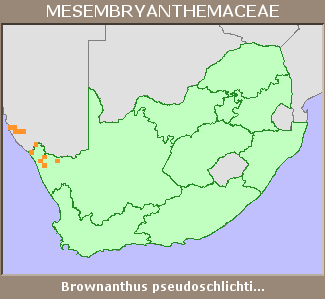Jürgens, N., Schmiedel, U., Haarmeyer, D.H., Dengler, J., Finckh, M., Goetze, D., Gröngröft, A., Hahn, K., Koulibaly, A., Luther-Mosebach, J. and Muche, G. 2012. The BIOTA Biodiversity Observatories in Africa—a standardized framework for large-scale environmental monitoring. Environmental monitoring and assessment 184(2):655-678.
Klak, C., Bruyns, P.V. and Hedderson, T.A.J. 2007. A phylogeny and new classification for Mesembryanthemoideae (Aizoaceae). Taxon 56(3):737-756.
Raimondo, D., von Staden, L., Foden, W., Victor, J.E., Helme, N.A., Turner, R.C., Kamundi, D.A. and Manyama, P.A. 2009. Red List of South African Plants. Strelitzia 25. South African National Biodiversity Institute, Pretoria.
Snijman, D.A. 2013. Plants of the Greater Cape Floristic Region 2: The extra Cape flora. Strelitzia 30. South African National Biodiversity Institute, Pretoria.
|
 Comment on this assessment
Comment on this assessment

